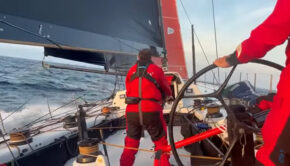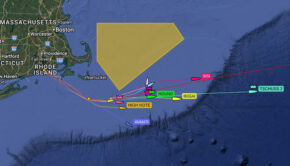Autopilots okay for NYYC Transatlantic
Published on March 13th, 2024
It’s the middle of a foggy night in the North Atlantic. The breeze is fickle and there is nary a star or landsight by which to guide the yacht. It’s the sort of weather than drives helmspeople insane as they chase the compass this way and that, trying, often in vain, to find some semblance of equilibrium. Unless, of course, the steering is being handled by autopilot.
To date, one of the maxims of fully crewed American offshore racing has been that there must be, at all times, a human hand on the helm. For the Transatlantic Race 2025 from the USA to England, this will not be the case as a new amendment to the Notice of Race will allow for autopilots throughout the fleet.
“The Transatlantic Race 2025 is a bucket-list race for many experienced racers and racer-cruisers and this decision targets that second group,” says Dan Litchfield, co-chair for the race. “We are keenly aware of the planning and logistics that go into supporting a crew, and this difficulty scales up with crew size.
“The main motivation for allowing autopilots is to encourage participation by enabling boats, especially in the racer-cruiser division, to compete safely and effectively with fewer team members.”
The Transatlantic Race 2025 is organized by the New York Yacht Club and the Royal Ocean Racing Club, with support from the Royal Yacht Squadron and the Storm Trysail Club. The race will start from Newport, RI on June 18 and finish off Cowes, England.
Autopilots have been around for centuries, evolving from the simple act of tying off the tiller to the windvane-controlled steering systems pioneered by round-the-world racers in the 1960s to computer-controlled systems that rely on supplied power and are integrated into the design of a yacht’s steering assembly.
At the top end, the algorithms powering state-of-the-art autopilots have become more complex and often better than humans at reacting to changing conditions while more traditional ocean racing yachts with autopilots tend to rely primarily on heading and wind direction inputs to keep the boat on track.
In England and the rest of Europe, the use of autopilots for similar races is more common. The Rolex Middle Sea Race Rolex has allowed them at least since 2018. The Rolex Fastnet Race added the permission for all boats to utilize autopilots to its NOR for the 2023 edition.
“The RORC has found that the introduction of autopilots has helped boats with less crew to take part in our longer distance races,” says Steve Cole, racing manager for the RORC.
The United States has lagged when it comes to this tweak to Rule 52 of the Racing Rules of Sailing. And while that may continue to be the case for many of the races in the United States, a 3,000-mile race that could take some teams as long as three weeks to finish is the best event to test out a change to the paradigm.
Event information – Race details – Entry list
Competitors will cover a distance of approximately 3,000 miles with IRC handicap scoring to determine the winners in each division. The 2025 edition will be the 32nd Transatlantic sailing competition organized by the New York Yacht Club.
Source: NYYC









 We’ll keep your information safe.
We’ll keep your information safe.